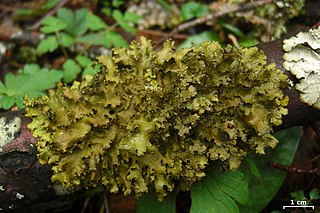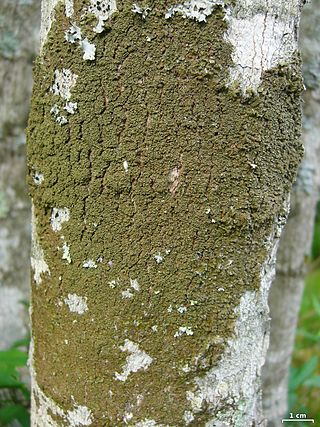
Parmelia is a genus of medium to large foliose lichens. It has a global distribution, extending from the Arctic to the Antarctic continent but concentrated in temperate regions. There are about 40 species in Parmelia. In recent decades, the once large genus Parmelia has been divided into a number of smaller genera according to thallus morphology and phylogenetic relatedness.

The Parmeliaceae is a large and diverse family of Lecanoromycetes. With over 2700 species in 71 genera, it is the largest family of lichen-forming fungi. The most speciose genera in the family are the well-known groups: Xanthoparmelia, Usnea, Parmotrema, and Hypotrachyna.

Ahtiana is a genus of lichenized fungi known as candlewax lichens in the family Parmeliaceae. A monotypic genus, it contains the single species Ahtiana sphaerosporella or the mountain candlewax lichen, found in western North America. This species was segregated from the genus Parmelia by Canadian lichenologist Trevor Goward in a 1985 publication. It had been suggested that the genus include A. aurescens and A. pallidula based on similarities in morphology, but this transfer is not supported by molecular analysis.

Allocetraria is a genus of lichenized fungi in the family Parmeliaceae. It consists of 12 species, with a center of distribution in China.

Arctocetraria is a genus of foliose lichens in the family Parmeliaceae. It has three species.

Kaernefeltia is a genus of lichenized fungi in the family Parmeliaceae.

Masonhalea is a genus of two species of lichenized fungi in the family Parmeliaceae.

Vulpicida is a genus of lichenized fungi in the family Parmeliaceae. Circumscribed in 1993 to contain species formerly placed in Cetraria, the genus is widespread in Arctic to northern temperate regions, and contains six species. The genus is characterized by the presence of the secondary metabolites pulvinic acid and vulpinic acid, compounds that when combined with usnic acid, give the species their characteristic yellow and green colors.

Tuckermannopsis is a genus of foliose lichens in the family Parmeliaceae.

Melanohalea is a genus of foliose lichens in the family Parmeliaceae. It contains 30 mostly Northern Hemisphere species that grow on bark or on wood. The genus is characterized by the presence of pseudocyphellae, usually on warts or on the tips of isidia, a non-pored epicortex and a medulla containing depsidones or lacking secondary compounds. Melanohalea was circumscribed in 2004 as a segregate of the morphologically similar genus Melanelia.

Cetrelia is a genus of leafy lichens in the large family Parmeliaceae. They are commonly known as sea-storm lichens, alluding to the wavy appearance of their lobes. The name of the genus, circumscribed in 1968 by the husband and wife lichenologists William and Chicita Culberson, alludes to the former placement of these species in the genera Cetraria and Parmelia.

Punctelia is a genus of foliose lichens belonging to the large family Parmeliaceae. The genus, which contains about 50 species, was segregated from genus Parmelia in 1982. Characteristics that define Punctelia include the presence of hook-like to thread-like conidia, simple rhizines, and point-like pseudocyphellae. It is this last feature that is alluded to in the vernacular names speckled shield lichens or speckleback lichens.

Xanthoparmelia is a genus of foliose lichen in the family Parmeliaceae. Xanthoparmelia is synonymous with Almbornia, Neofuscelia, Chondropsis, Namakwa, Paraparmelia, and Xanthomaculina. This genus of lichen is commonly found in the United States, as well as Australia, New Zealand and Ecuador.
Everniopsis is a fungal genus in the family Parmeliaceae. It consists of a single species, the bark-dwelling lichen Everniopsis trulla, which occurs in Africa and South America.

Tuckermanella is a genus of lichen-forming fungi in the family Parmeliaceae.
Coelopogon is a genus of lichen-forming fungi in the family Parmeliaceae. The genus contains two species found in southern South America and South Africa.

Esslingeriana is a fungal genus in the family Parmeliaceae. The genus is monotypic, containing the single foliose lichen species Esslingeriana idahoensis, commonly known as the tinted rag lichen. It is found in northwestern North America.
Jan Eric Ingvar Kärnefelt is a Swedish lichenologist.
Melanohalea zopheroa is a species of lichen in the family Parmeliaceae. It was first formally described in 1977 by Ted Esslinger as Parmelia zopheroa. A year later, he transferred it to the new genus Melanelia, which he created to contain the brown Parmeliae species. In 2004, after early molecular phylogenetic evidence showed that Melanelia was not monophyletic, Melanohalea was circumscribed by lichenologists Oscar Blanco, Ana Crespo, Pradeep K. Divakar, Esslinger, David L. Hawksworth and H. Thorsten Lumbsch, and M. zopheroa was transferred to it. The lichen has a disjunct distribution, as it is found in South America (Chile) and in New Zealand.

Usnocetraria is a genus of foliose lichens in the family Parmeliaceae.
















